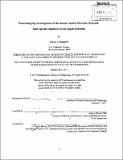| dc.contributor.advisor | Anne J. Blood. | en_US |
| dc.contributor.author | Makhlouf, Miriam L | en_US |
| dc.contributor.other | Harvard--MIT Program in Health Sciences and Technology. | en_US |
| dc.date.accessioned | 2013-06-17T19:50:32Z | |
| dc.date.available | 2013-06-17T19:50:32Z | |
| dc.date.copyright | 2013 | en_US |
| dc.date.issued | 2013 | en_US |
| dc.identifier.uri | http://hdl.handle.net/1721.1/79249 | |
| dc.description | Thesis (Ph. D. in Speech and Hearing Bioscience and Technology)--Harvard-MIT Program in Health Sciences and Technology, 2013. | en_US |
| dc.description | Cataloged from PDF version of thesis. | en_US |
| dc.description | Includes bibliographical references. | en_US |
| dc.description.abstract | Laryngeal dystonia (LD) is the focal laryngeal form of the neurological movement disorder called dystonia, a condition that often changes in severity depending on the posture assumed and on voluntary activity of the affected body area. Pathophysiology of dystonia is unknown. This thesis employed a combination of diffusion tensor and functional magnetic resonance imaging (DTI and fMRI) studies to investigate the structure and function of the basal ganglia (BG) in dystonia patients. Fractional anisotropy (FA) and probabilistic diffusion tractography analyses were used to investigate the questions of whether LD patients exhibited altered connectivity between BG and brainstem regions and whether FA and tractography could be used to predict differences in clinical presentations of dystonia. Findings of this study support the hypothesis that connections between the BG and brainstem may play a role in dystonia pathophysiology and may be used to predict differences in clinical presentations of dystonia. An fMRI study was carried out to investigate whether abnormally sustained BG activity observed after performance of a finger tapping task in hand dystonia patients may represent an amplification of a normal motor control mechanism. As dystonia has been hypothesized to result from overactivation of normal postural programs, this study aimed to investigate the question of whether the sustained BG activity was a normal feature observed in motor control tasks requiring more precision. Results suggest that cerebellar cortex is recruited particularly during fine motor control. | en_US |
| dc.description.statementofresponsibility | by Miriam L. Makhlouf. | en_US |
| dc.format.extent | 118 p. | en_US |
| dc.language.iso | eng | en_US |
| dc.publisher | Massachusetts Institute of Technology | en_US |
| dc.rights | M.I.T. theses are protected by
copyright. They may be viewed from this source for any purpose, but
reproduction or distribution in any format is prohibited without written
permission. See provided URL for inquiries about permission. | en_US |
| dc.rights.uri | http://dspace.mit.edu/handle/1721.1/7582 | en_US |
| dc.subject | Harvard--MIT Program in Health Sciences and Technology. | en_US |
| dc.title | Neuroimaging investigation of the motor control disorder, dystonia with special emphasis on laryngeal dystonia | en_US |
| dc.type | Thesis | en_US |
| dc.description.degree | Ph.D.in Speech and Hearing Bioscience and Technology | en_US |
| dc.contributor.department | Harvard University--MIT Division of Health Sciences and Technology | |
| dc.identifier.oclc | 846479662 | en_US |
